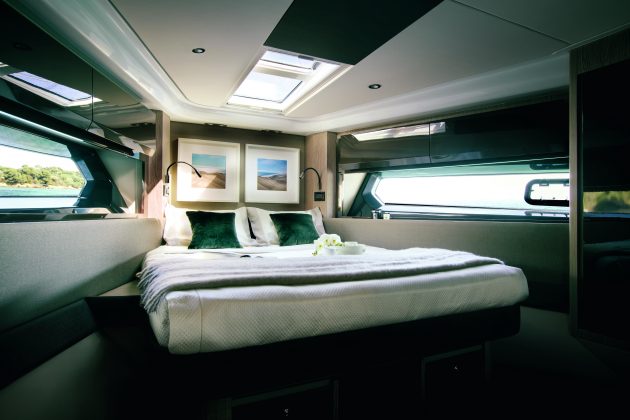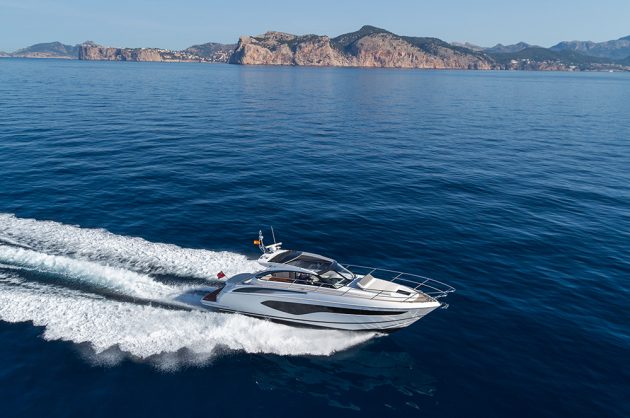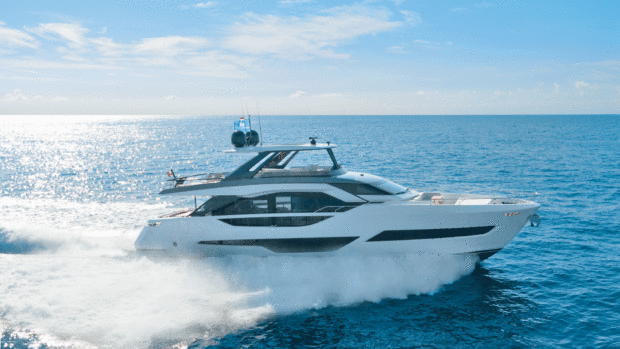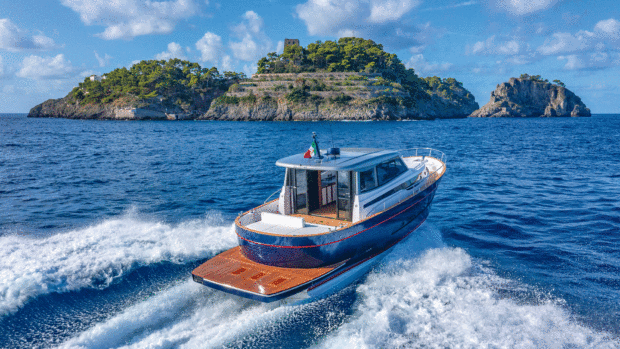The flagship of the Azimut Atlantis range is a throwback to how sportscruisers used to be, but can it still compete with the more versatile competition?
The flagship of Azimut’s attractive Atlantis range is a rare beast.
There is no shortage of handsome and capable 50ft sportscruisers to choose from but there are few, if any, that do away with the ubiquitous aft doors to offer an open-backed cockpit in the mould of how sportscruisers of this size used to
be.
Azimut is banking on the idea that sportscruisers have drifted too far away from their roots in offering enclosed upper saloons and that there is a place in the market for one that puts the party on deck and the apartment downstairs. You can, if you search deep enough in the options list, have cockpit doors, but the very suggestion of this draws pained expressions from the members of the Azimut team who join me on board for our test.
The first rule of sportscruiser design is that it must look good, and thanks to the handiwork of the young two-man team at Neo Design, that box has been thoroughly ticked.
With an overall length of 53ft 1in (16.2m) the proportions are sweet, the snub-nosed bow fronting a long and elegant foredeck, which raises neatly to take the sweeping roofline up and over the cockpit to a pert overhang. The windows in the topsides are large and unfussy, prominent without detracting from the overall profile. It’s a good looking craft, especially in the optional silver paint of our test boat, one that you can’t help but take a second glance at as you walk away. As well as its silver topsides and superstructure, hull number one – which we are testing, and Azimut is at pains to point out is still classified as a prototype – also has a silver finish to the cockpit mouldings. It’s an option that offers extra pizzazz, something a little different to the usual vista of sterile white mouldings.
I wasn’t so taken by the white/platinum Esthec decking, however, which looks cheap and, judging by the amount of black marks and scuffs on a boat with so few hours on the engines, will be a nightmare to keep clean.
Thankfully you can opt for a more standard biscuit colour or the real thing, though it sits a long way down the options list.
The cockpit is dominated by a sunpad large enough for four adults to comfortably lie on and soak up the sun
side-by-side. Beneath it there is a tender garage that can swallow a Williams 325, though this does badly impede access to the engineroom. The hardtop’s short overhang keeps unwanted shadow off the sunpad but the omission of an extending canopy means you can’t add sun protection even if you wanted to.
A walkway to starboard leads into a cockpit that has a flat floor all the way forward to the companionway. The seat squabs of the small bench to starboard detach from their nests and pull out to become stools for the folding dinette table. This neat trick allows ten people to easily arrange themselves around the table to eat with the wetbar within close reach. That said, due to the size of the standard BBQ grill it is located on the transom, great for keeping smoke and food smells off the boat but not quite so convenient for the cook who has to ferry food back and forth.
The helm station is attractive and sensibly arranged, if compact for a boat of this size, and only has space for a single chartplotter. A floating plinth juts out into the companionway to support the helm seat that is inboard of the navigator, but
its central location improves the view.
On the opposite side of the companionway there is a raised area that is part seating, part sunpad. It works better as a sunpad because when you’re on the move the long, high seat base puts your legs out in front of you, meaning your
back will take any impact. It would be better to have a proper bench seat here rather than creating a sunpad where there isn’t the need for one, especially when there is a four-person sunpad up front with a pram hood for shade.Part of the issue is that the sunroof is small and made of solid GRP. In an era of heavily glazed solid sunroofs or folding canvas ones with enormous apertures, the 51’s offering falls short and its tendency to rattle suggests the mechanism itself could do with fine tuning. If the 51 is all about life on deck then Azimut has dropped the ball with the diminutive size of its sunroof.
Down below
Below decks Neo Design’s creative juices flow freely and the Atlantis dazzles with Italian chic. There’s a delightful mix of materials and textures from the oak staircase to the dark wenge flooring and, higher up on the eye-level lockers, a glossy lacquer in a classy coffee hue.
The sofa extends back past the companionway staircase to maximise space and is arranged opposite a galley that looks great but is short on storage space. There is a full- height fridge/freezer, however.

The cabin layout is unusual because the master ensuite is forward with the space amidships shared by a pair of guest cabins. This is another throwback to sportscrusiers of old and the forward master demonstrates that the cabin can be located here without it feeling compromised. It is spacious and brightened up by a pair of long side windows and double hatches overhead. There is enough room at the end of the bed for a couple of people to get changed and there’s also space for a dinky vanity station plus three large hanging lockers. With the day heads located aft, the owners will have their own spacious ensuite all to themselves.

Working aft, you find the pair of guests cabins with a bunk bed cabin to port and a larger VIP to starboard that has the option of a queen-size double bed or a pair of singles that slide together to make a double. The bunks are fine for adults but better suited to kids and the VIP, or “mini master” as Azimut ambitiously calls it, is a pleasant, versatile space with enough storage to keep guests happy during longer stays. Neither of these cabins are ensuite, however, and they share the bathroom
that also doubles as the day heads so there could be queues at bed time.
Drive time
If the first rule of sportscruiser is good looks then the second is a rewarding driving experience. Few people will be chucking these boats around like Class 1 racers but it’s nice to know that they have a bit of bite when you open the taps.
Azimut has hedged its bets with just one engine option: Volvo Penta’s IPS800 with 600hp per side. With this the only choice there is no room for error and thankfully the 51 performs beautifully.
The motors kick it on to the plane with urgency but remain smooth and refined when you want to set the throttles and soak up the miles. This is where the 51 excels, though its steering is light and positive it’s the boat’s ability to cruise between 18 and 32 knots that is most appealing. Top speed on test was a useful 34.5 knots with tanks a quarter full and a Pirelli tender in the garage.

The steering is well weighted but, in the usual IPS manner, you soon run out of lock and find the boat levelling out.
Azimut’s enormous steering wheel, plucked straight from one of its larger flybridge models, feels cumbersome on this boat and it’s hard to spin from lock to lock. Something smaller would be easier to handle and wouldn’t hog so much of
the available dashboard space. Small qualms like this, and the joystick and throttle needing to swap positions, don’t detract from what is generally a very positive driving experience. Sadly the calm conditions of our test day meant that we couldn’t thoroughly challenge the hull but it romped over the crests of our own wake confidently enough.
A happy by product of the 51 having an open cockpit is that you actually feel as if you are on a boat. You can hear the engines and the water rushing past the hull, which makes a pleasant change to being sealed off from the action in an air-conditioned box.
How does it stack up regarding price? Well it’s certainly towards the top end of the scale, the starting price coming in at around €90,000 more than the Princess V50 Open and €170,000 more than the admittedly cheaper feeling Beneteau Gran Turismo 50. In fairness to the Italian boat it has larger engines than its rivals but though you can see and feel its quality
over the Beneteau it doesn’t feel any better put together than the British boats.
On the face of it, it’s hard to see how the Atlantis 51 can hold a torch to the more versatile Princess V50, Beneteau Gran Turismo 50 or Sunseeker’s all-new Predator 50. These boats, with their enclosed saloons and adaptable layouts are the better choice if you wish to use the boat all year round or if it is going to be based in northern Europe or other areas with a more changeable climate. However, if you will only use the boat when the weather is perfect and life on deck is a concern above all else then the big Atlantis charges to the front of the pack.
Verdict
Ultimately, this boat’s appeal will hinge on the environment in which it is kept.
For pure fun in the sun it’s a hard recipe to beat but if you want something with an all court game there are rivals out there that offer more.
The integration of the helm seat is neatly done and it’s helpful that two people can sit at the helm on passage. That said, the navigator does sit outboard of the skipper.
At a glance…
Fuel capacity: 317 imp gal (1,440 litres)
Water capacity: 99 imp gal (450 litres)
Draughts: 4ft 3in (1.3m)
RCD category: B for 12 people
Designers: Neo Design
Displacement: 22 tonnes (loaded)
Contact: Azimut

Boat test: Bénéteau GT 50 Coupé vs Sportfly
With a sleek Coupé and a Sportfly model to choose from, the new Bénéteau Gran Turismo 50 has a foot

Southampton Boat Show 2018: Princess unveils full yacht line up
Princess Yachts have announced their full yacht line up which will be showcased at the Southampton Boat Show, 14 -

Princess announces its Cannes Yachting Festival line up featuring three global launches (promotional post)
The V60, Princess 70 and R35 will get their global premiere, whilst the V65 and V50 will be presented on










